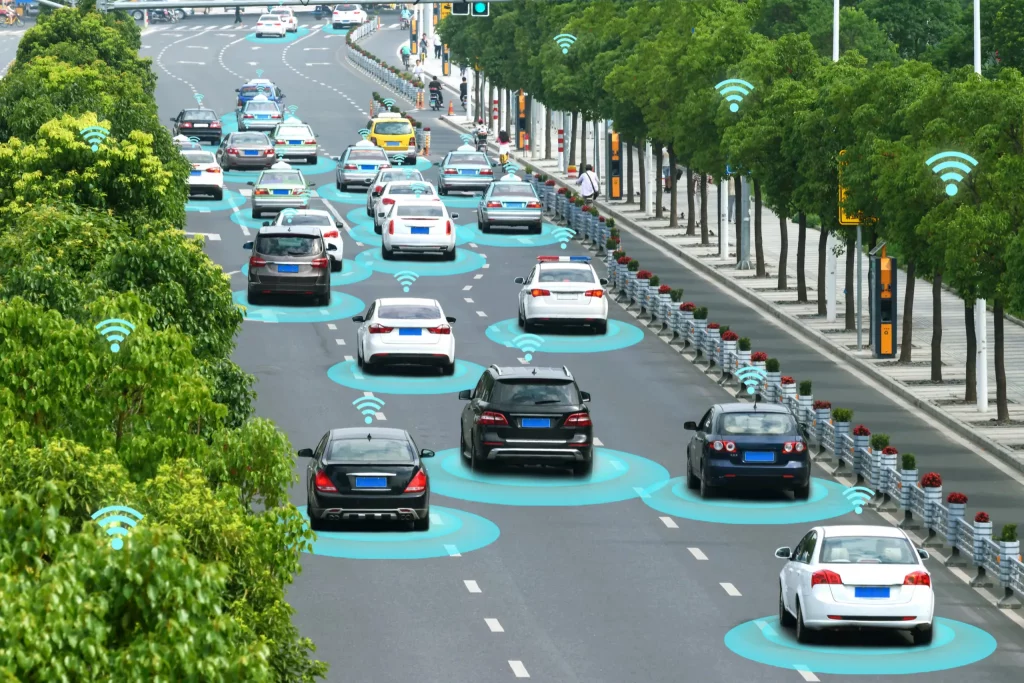& Construction

Integrated BIM tools, including Revit, AutoCAD, and Civil 3D
& Manufacturing

Professional CAD/CAM tools built on Inventor and AutoCAD
3 min read
This post is also available in: Italiano (Italian) Deutsch (German) 日本語 (Japanese)
Learn about five artificial intelligence applications across various industries, such as automotive manufacturing and social media.

The artificial intelligence (AI) market is booming as humans continue to create technology far beyond anything previously invented in the last decade. Whether it’s systems that track biometrics, self-driving cars, software that tracks finances, or GPS applications that provide the most fuel-efficient route, it’s no secret that AI technology is helping simplify our day-to-day lives.
As time goes on, AI continues to spread from one industry to the next and will eventually help engineers achieve monumental goals never thought possible.
Artificial intelligence is the simulation of human intelligence composed of machines and deep learning computer software. Simply put, it is a simulated neural network. It exists on specialized software and hardware with machine learning algorithms written in a programming language like Java or Python. AI learns by collecting data, analyzing the data for patterns, and then using those patterns to make logical predictions about future states.
Chatbots on company websites are basic AI systems that use data from real chats. Chatbots are programmed and provided datasets from real chats. The chatbot runs an algorithm to learn patterns from text examples and incorporates problem-solving mechanics. This allows the chatbot to simulate lifelike exchanges with real people by identifying familiar text fed into the chat. The chatbot has a database consisting of millions of examples to pull appropriate responses from.
AI is important because it is versatile and helps humans perform repetitive tasks faster and far more accurately. AI is being used in industries worldwide and provides new ways to innovate old technology and create new technology. Some examples of modern AI applications are self-driving cars, finance tracking, transportation taxi services (Uber), social media algorithms, and generative design in CAD software.

Thanks to AI development and LiDAR technology, self-driving cars are now a reality. Some market research predicts that more than 33 million self-driving cars will be on the roads by 2040 – supply chain issues notwithstanding.
Self-driving cars utilize a series of sensors positioned around the entirety of the vehicle. The sensors capture thousands of data points in real-time within a millisecond. Some data points include car speed, road conditions, pedestrian positions, lines on the road, and other car positions. AI helps interpret the data and execute mechanical reactions within milliseconds to avoid collisions and breaking motor laws.
The AI technology behind self-driving cars is still in its infancy, but the future looks promising — new advancements may lead to fully autonomous personal vehicles.
The financial industry relies on accurate, real-time reporting and processing of quantitative data. What better place for AI than a space where people consume, analyze, and react to data within a few seconds? The financial sector uses chatbots, adaptive intelligence, algorithmic trading, and machine learning to help investors stay on track with trading, saving, and selling. AI also uses the data gathered from financial markets to predict the best stock purchase or portfolio.

Uber is just one of the many companies that utilize AI to help get people from point A to B without waiting on a switchboard operator. Most people make travel arrangements on their smartphones, and companies are beginning to capitalize on smartphone usage. Modern travel agencies now exist in a digital space online. AI chatbots and virtual assistants help users plan trips worldwide with little more than a few clicks and text prompts.
Social media has grown significantly over the last decade with the increased usage of smartphones, and wearable devices, with more than 2 billion active profiles across Facebook, Snapchat, Twitter, and Instagram. AI runs chatbots and provides relevant posts to users based on their previous search history. With an influx of misleading information across various social media platforms, it’s possible that AI could help in the future.

Generative design in Fusion 360 utilizes AI technology to produce high-performing design alternatives from a singular design idea. Generative design gathers input data — spatial requirements, materials, manufacturing methods, and cost constraints — the engineer provides to create hundreds of feasible alternatives to the original design. The AI tests and learns from each successful and unsuccessful iteration, ultimately creating design options you might not have thought of yourself.
Artificial intelligence and AI research aren’t going anywhere and will continue to enhance the technology we already know and love. There are many other AI applications too, such as recognition, facial recognition, natural language processing, speech recognition, and combat training in video games.
Try generative design in Fusion 360 for yourself to experience AI-driven CAD.

By clicking subscribe, I agree to receive the Fusion newsletter and acknowledge the Autodesk Privacy Statement.
Success!
May we collect and use your data?
Learn more about the Third Party Services we use and our Privacy Statement.May we collect and use your data to tailor your experience?
Explore the benefits of a customized experience by managing your privacy settings for this site or visit our Privacy Statement to learn more about your options.